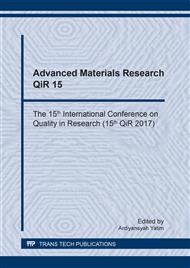p.177
p.186
p.191
p.200
p.209
p.218
p.225
p.234
p.243
Utilization of Fly Ash and Nickel Slag PT - Antam as Material Subtitution for Concrete
Abstract:
The use of concrete for road and bridge work has long been used, and nearly 80% of the bridge elements made of concrete. In concrete, aggregates it self-occupies 70% to 75% of the volume of concrete, so the quality of aggregates influence on the properties of concrete. High demand for concrete also increases demand for aggregates. As a result of the increased demand for aggregates, exploration of natural materials would potentially harm the environment. In addition, as fuel prices increase, resulting in increasing prices of construction materials and other basic commodities. Because of that, many industries switched to using coal as an alternative fuel. PT. Antam as one of the nickel mining industry also used coal as an alternative fuel. The result of using coal as fuel is the production of residual waste coal that is fly ash. The nickel production also produces nickel slag as residual waste that contains very small amount of nickel and not economically to recovered. To reduce by-product of nickel mining industry, a research use of fly ash and nickel slag as a substitution material for concrete rigid pavement was investigated. The purpose of this research, to characterized the chemical and physical fly ash and nickel slag properties. The last step of this research is the analysis of the effects of the use fly ash and nickel slag on the compressive strength of concrete as the main indicator of the strength of concrete.
Info:
Periodical:
Pages:
243-250
Citation:
Online since:
August 2018
Authors:
Keywords:
Price:
Сopyright:
© 2018 Trans Tech Publications Ltd. All Rights Reserved
Share:
Citation:


